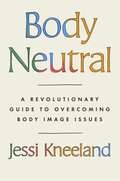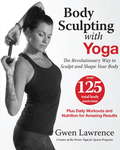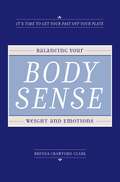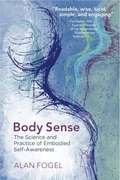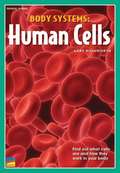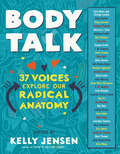- Table View
- List View
Body Massage for the Beauty Therapist
by Audrey Goldberg Lucy McdonaldThe beauty therapist, increasingly called upon to administer massage, will welcome this manual. Its modern and practical approach will appeal to all who wish to improve their standard of massage. The physical comfort and reassurance which massage can give, especially when coupled with exercises, make it more than a sensuous luxury: rather it is a positive factor in promoting bodily wellbeing. The clear and detailed explanations of massage techniques in 'Body Massage for the Beauty Therapist' are supplemented by many drawings and photographs, which also serve to clarify the structure of the human body and its functioning. The personality and qualities of the therapist are brought into perspective and helpful advice given on the organization of the salon. Valuable sections are included on relaxation techniques, correct breathing and exercises which the client can undertake. Aromatherapy and gyratory massage are also covered.
Body Matters: A Phenomenology of Sickness, Disease, and Illness
by James AhoFollowing the core principle of phenomenology as a return 'to the things themselves,' Body Matters attends to the phenomena of bodily afflictions and examines them from three different standpoints: from society in general that interprets them as 'sicknesses,' from the medical professions that interpret them as 'diseases,' and from the patients themselves who interpret them as 'illnesses.' By drawing on a crucial distinction in German phenomenology between two senses of the body_the quantifiable, material body (Ksrper) and the lived-body(Leib)_the authors explore the ways in which sickness, disease, and illness are socially and historically experienced and constructed. To make their case, they draw on examples from a multiplicity of disciplines and cultures as well as a number of cases from Euro-American history. The intent is to unsettle taken-for-granted assumptions that readers may have about body troubles. These are assumptions widely held as well by medical and allied health professionals, in addition to many sociologists and philosophers of health and illness. To this end, Body Matters does not simply deconstruct prejudices of mainstream biomedicine; it also constructively envisions more humane and artful forms of therapy.
Body Metabolism and Exercise (Advances in Experimental Medicine and Biology #840)
by Mieczyslaw PokorskiThe dynamics of body metabolism are changed in the disease process and interact with physical activity. The alteration of metabolism and its consequences raise the need for simple and reliable methods for assessment of body composition. The chapters aim to investigate various interacting components converging on metabolic changes in lung and muscle tissues taking into consideration the drug effects. The effects of exercise and nutritional status are dealt with at a great extent.
Body Mind Movement: An evidence-based approach to mindful movement
by Jennifer PilottiBody Mind Movement: An Evidence-Based Approach to Mindful Movement explores the foundational concepts behind the science of learning, motor control, and body awareness. The book features case studies, exercises to illustrate the concepts, and opportunities for critical thinking, allowing movement professionals not only to understand the science behind why techniques and modalities work, but also to explore ways of implementing these approaches with their patients.The work is written for the curious movement professional who wants to enhance their ability to work with students of all ages and abilities.To learn more about Jenn's in-person workshops and retreats, please visit www.jennpilotti.com
Body Movement: Coping with the Environment
by Irmgard Bartenieff Dori Lewis"'Irmgard Bartenieff has a profound knowledge of the human body and how it moves. I am delighted that this will now be made available to many more people.'." -- George Balanchine of Director, New York City Ballet"'Irmgard Bartenieff's pioneering work in the multiple applications of Labananalysis has had a transforming influence on many areas of movement training. Her careful and detailed development of the spatial principles into active corrective work has illuminated and altered the training of people as varied as dancers, choreographers, physical therapists, movement and dance therapists, and psychotherapists. Anthropologists and non-verbal communication researchers have found their world view necessarily altered by her fundamental innovations. The field of body/mind work will need to adapt to include her clear working through of basic principles.'." -- Kayla Kazahn Zalk of President, American Dance Guild
Body Neutral: A Revolutionary Guide to Overcoming Body Image Issues
by Jessi Kneeland&“An incredible resource for those who are looking to find greater peace with their bodies in order to live a more empowered, joyful, and meaningful life.&” —Matt McGorryA life-changing guide to reclaiming your relationship with your body—and yourselfHave you ever thought that if only you could change the way you looked, your life would be better? It&’s so easy to imagine that by changing the outside of our bodies, we&’d feel better on the inside. But we all know that even if we could magically attain a so-called &“perfect&” body, our problems wouldn&’t actually be solved. That&’s because body image issues are never just about the body: they&’re always about something deeper inside.As a longtime personal trainer and coach, Jessi Kneeland has seen hundreds of clients achieve their fitness goals but still feel trapped in a web of body hatred, anxiety, obsession, and dysmorphia. Searching for a solution, Kneeland set out on a quest to discover what it truly takes to help people understand, process, and heal their body image issues for good. They share their discoveries in Body Neutral, where you&’ll learn: The power of &“body neutrality&”—the ability to accept and respect your body, even if it isn&’t the way you&’d prefer it to be.Which of the four &“body image avatars&”—each of which represents a different root cause for body image issues—aligns with you and your relationship with your body: the self-objectifier, the high achiever, the outsider, or the runner.Actionable and unique methods to help you strip away the layers of false meaning, excess power, moral significance, and shame that have been preventing you from both connecting to and appreciating your body, and feeling truly worthy as a person. There is a reason you&’re unhappy with your body, and Body Neutral will help you discover what that reason is and how to defuse its power, freeing you to enjoy a life of true confidence, security, and satisfaction.
Body Neutral: A revolutionary guide to overcoming body image issues
by Jessi KneelandA life-changing guide to reclaiming your relationship with your body and yourselfHave you ever thought that if only you could change the way you looked, your life would be better? It's so easy to imagine that by changing the outside of our bodies, we'd feel better on the inside. But we all know that even if we could magically attain a so-called 'perfect' body, our problems wouldn't actually be solved. That's because body image issues are never just about the body: they're always about something deeper inside.As a longtime personal trainer and coach, Jessi Kneeland has seen hundreds of clients achieve their fitness goals but still feel trapped in a web of body hatred, anxiety, obsession and dysmorphia. Searching for a solution, Kneeland set out on a quest to discover what it truly takes to help people understand, process and heal their body image issues for good. They share their discoveries in Body Neutral, where you'll learn:* The power of 'body neutrality' - the ability to accept and respect your body, even if it isn't the way you'd prefer it to be.* Which of the four 'body image avatars' - each of which represents a different root cause for body image issues - aligns with you and your relationship with your body: the self-objectifier, the high achiever, the outsider or the runner.* Actionable and unique methods to help you strip away the layers of false meaning, excess power, moral significance and shame that has been preventing you from both connecting to and appreciating your body and feeling truly worthy as a person.There is a reason you're unhappy with your body, and Body Neutral will help you discover what that reason is and how to defuse its power, freeing you to enjoy a life of true confidence, security and satisfaction.
Body Neutral: A revolutionary guide to overcoming body image issues
by Jessi KneelandA life-changing guide to reclaiming your relationship with your body and yourselfHave you ever thought that if only you could change the way you looked, your life would be better? It's so easy to imagine that by changing the outside of our bodies, we'd feel better on the inside. But we all know that even if we could magically attain a so-called 'perfect' body, our problems wouldn't actually be solved. That's because body image issues are never just about the body: they're always about something deeper inside.As a longtime personal trainer and coach, Jessi Kneeland has seen hundreds of clients achieve their fitness goals but still feel trapped in a web of body hatred, anxiety, obsession and dysmorphia. Searching for a solution, Kneeland set out on a quest to discover what it truly takes to help people understand, process and heal their body image issues for good. They share their discoveries in Body Neutral, where you'll learn:* The power of 'body neutrality' - the ability to accept and respect your body, even if it isn't the way you'd prefer it to be.* Which of the four 'body image avatars' - each of which represents a different root cause for body image issues - aligns with you and your relationship with your body: the self-objectifier, the high achiever, the outsider or the runner.* Actionable and unique methods to help you strip away the layers of false meaning, excess power, moral significance and shame that has been preventing you from both connecting to and appreciating your body and feeling truly worthy as a person.There is a reason you're unhappy with your body, and Body Neutral will help you discover what that reason is and how to defuse its power, freeing you to enjoy a life of true confidence, security and satisfaction.
Body Positive Power: Because Life Is Already Happening and You Don't Need Flat Abs to Live It
by Megan Jayne CrabbeA body-positive call to arms that's as inspirational as it is practical, from Instagram star Megan Jayne Crabbe For generations, women have been convinced that true happiness only comes when we hit that goal weight, shrink ourselves down, and change ourselves to fit a rigid and unrealistic beauty ideal. We've been taught to see our bodies as collections of problems that need to be fixed. Instagram star Megan Jayne Crabbe is determined to spread the word that loving the body you have is the real path to happiness. An international body positive guru with fans in all corners of the world, Megan spent years battling eating disorders and weight fluctuations before she found her way to body positivity. She quit dieting, discovered a new kind of confidence, and replaced all those old feelings of body shame and self-recrimination with everyday joy. Free of the pressure to fit in a size 2, her life became more satisfying than ever before.In her debut book, Megan shares her own struggles with self-acceptance and her path to body positivity. With whip-smart wit and a bold attitude that lights up her Instagram feed, Megan champions a new worldview for all of us: It's time to stop dieting and get on with your life.
Body Process: Working With The Body In Psychotherapy
by James I. KepnerTraditional psychotherapy approaches, focusing on working with and correcting mental events and conditions, have placed little importance on the fundamentally physical nature of the person. Yet many of the problems people bring to therapy are linked with or manifested in the body--such as obesity, psychosomatic distress, chronic tension, and sexual problems. This book provides a therapeutic approach that addresses both the physical and mental nature of clients. In this book, James Kepner shows that a client's posture, movements, and bodily experiences are indeed relevant to therapy, and he offers an insightful framework for incorporating these aspects into a therapeutic framework. This comprehensive treatment explains how body work can be integrated with the aims, methods, and philosophy of psychotherapy, offering a framework within which practitioners of different theoretical approaches can better appreciate body processes in the context of the whole person, rather than as isolated events. This book, including an updated introduction by the author, explores the range of body work in psychotherapy, from the development of body awareness to intensive work with physical structure and expression. And it demonstrates how this approach can be particularly effective with a range of clients, including survivors of sexual abuse, recovering drug addicts or alcoholics, or those suffering from chronic illness.
Body Reading Plain & Simple: The Only Book You'll Ever Need (Plain & Simple Series)
by Sasha FentonWe all know that hands can reveal character and destiny, but what about other parts of the body? With this basic guide, learn how your body features can reveal health, relationship, and behavior attributes and how to spot these in others. <P><P>Divination expert, Sasha Fenton covers the waterfront of body reading in 15 short accessible chapters. <P><P>Topics covered include faces, heads, hands, eyes, teeth, nails, feet, colors, moles, and itches. Generously illustrated with line drawings and graphs, this primer is a splendid introduction and guide to body secrets. <P><P>Fun facts found here: <P><P>Hair reflects one's health and one's state of mind. <P><P>Moles suggest stomach trouble, relationship problems, or possibly an ill partner. <P><P>A high bony nose suggests failure in business.Downwardly sloping eyebrows suggest a lack of energy and a tendency to whine. <P><P>People with inward-leaning incisors are selfish, antisocial, and don't mind hurting others. <P><P>Based on interviews, exhaustive research, and years of close observation, this practical guide is filled with fascinating facts and insight that will be greeted eagerly by all who are interested in a variety of divination systems.
Body Reading, Orion Plain and Simple: The Only Book You'll Ever Need (Plain and Simple)
by Sasha FentonA practical guide on how to read body features.We all know that hands can reveal character and destiny, but what about other parts of the body? With this basic guide, learn how your body features can reveal health, relationship and behaviour attributes and how to spot these in others.Divination expert, Sasha Fenton, covers the most important aspects of body reading in 15 short, accessible chapters. Topics covered include faces, heads, hands, eyes, teeth, nails, feet, colours, moles and itches. Generously illustrated with line drawings and graphs, this primer is a splendid introduction and guide to body secrets.Fun facts found here:· Hair reflects one's health and one's state of mind.· Moles suggest stomach trouble, relationship problems or possibly an ill partner.· A high bony nose suggests failure in business.· Downwardly sloping eyebrows suggest a lack of energy and a tendency to whine.Based on interviews, exhaustive research and years of close observation, this practical guide is filled with fascinating facts and insight that will be greeted eagerly by all who are interested in a variety of divination systems.
Body Recomposition: A Comprehensive and Metabolic Alternative to Weight Loss
by Kenneth Blum Debasis Bagchi Sanjoy Chakraborty Tandra R. Chakraborty Bernard W. DownsObesity is a global pandemic rising beyond the status of a lifestyle disorder, and its consequences include impaired metabolism, energy disruption, and abdominal fat deposition and storage. Body Recomposition: A Comprehensive and Metabolic Alternative to Weight Loss presents information on body recomposition, which emphasizes the approach of losing fat while gaining muscle. It contains vast research on topics including factors that influence fat accumulation, strategies for weight management, healthy diet and eating patterns, physical exercise, and lifestyle strategies in healthy weight management.Features: Influence of non-alcoholic fatty liver disease (NAFLD) on stored fat accumulation and its treatment Harnessing the gut microbial arm in combating obesity Roles of leptin, ghrelin, NPY, cortisol, and diverse neurotransmitters in appetite suppression and regulation Genetic predisposition and genetic addiction obesity risk assessment and therapies Gut–brain axis role in metabolism and body recomposition Efficacy of phytochemicals in weight management and roles of drugs and natural supplements in weight management Importance of physical exercise and manageable lifestyle factors Existing commercial weight loss strategies can fail to achieve and maintain sustainable weight loss or enhance greater healthy fat loss. This book provides an improved alternative for dietitians/nutritionists, health practitioners, and clinicians, as well as food and nutrition scientists.
Body Sculpting with Kettlebells for Men
by Roger Hall James Villepigue Hugo Rivera Catarina AstromThe complete guide to body sculpting with kettlebells.Unlike traditional dumbbells, the true power of the kettlebell lies in its unique shape. Because the kettlebell's center of mass is extended beyond the hand, more muscle groups are utilized in the swinging and movement of a kettlebell as opposed to the lifting of dumbbells, thus producing a much more effective workout. For this reason, the kettlebell has attracted attention from fitness professionals and is being increasingly adapted for the general public.For the first time ever, Body Sculpting with Kettlebells for Men gives readers a comprehensive guide to using this unique fitness tool, complete with workouts for people of all fitness levels. Simple to learn, easy to use and with a ton of benefits, Body Sculpting with Kettlebells for Men provides the perfect core or supplement to your existing workout routine.With Body Sculpting with Kettlebells for Men, you will learn:* How the kettlebell's shape enables endless variety of movement patterns* Sport-specific exercises to enhance performance* Quick, convenient exercises that can be practiced anytime with minimal equipmentUtilizing the unique and proven benefits of kettlebells, Body Sculpting withKettlebells for Men provides instructions, exercises, and routines perfect for gaining strength, packing on muscle, and burning body fat.Kettlebells are a surprisingly simple and incredibly effective tool that works more muscle groups than dumbbells for a full-body workout like you've never seen before.NEW AND EFFECTIVE. Kettlebells are quickly growing in popularity, both among fitness professionals and the general public for overall body sculpting work.NO GYM REQUIRED. With a small investment in the kettlebells equipment, the workouts can be done at home.ACCESSIBLE TO ALL FITNESS LEVELS. Includes detailed exercises for beginners and advanced exercisers. Includes workouts for building muscle mass, toning, and increasing cardio fitness.Body Sculpting with Kettlebells for Men takes this amazing potential and turns it into results, with pinpointed exercise routines and disciplined strength building workouts to maximize the benefits of your kettlebell program.What are you waiting for? Get fit NOW!
Body Sculpting with Kettlebells for Women
by Lorna KleidmanSave time on your workouts and look better than ever!Unlike traditional dumbbells, the kettlebell's center of mass is extended beyond the hand. Because more muscle groups are utilized in the swinging and movement of a kettlebell than during the lifting of dumbbells, a kettlebell workout is more effective, and yields better results in less time. The momentum generated by the kettlebell also reduces stress on the joints and minimizes the chance for injury. While the general public is starting to catch on to the power of the kettlebell, many kettlebell books on the market merely feature exercises for dumbbells, substituting the dumbbells with a kettlebell. This approach fails to maximize the efficacy and fun of the kettlebell as a workout tool. For the first time ever, Body Sculpting with Kettlebells for Women provides a female audience with kettlebell-specific workouts.Body Sculpting with Kettlebells for Women will teach you:*The differences between dumbbells and kettlebells*How the kettlebell's shape enables endless variety of movement patterns*Sport-specific exercises to enhance performance*Uniquely designed exercise programs to benefit all fitness levels*Where to buy kettlebells and which kettlebells are best for your fitness level*Basic nutritional guidelines for a more effective workoutWith easy to follow instructions, clear photographs, and extensive information on the kettlebell, Body Sculpting with Kettlebells for Women provides a comprehensive guide to this unique fitness tool, making these powerful workouts accessible to people of all fitness levels.Created by U.S.A.'s first International Master of Kettlebell Sport, Lorna Kleidman, this guide is sure to bring one of the most effective workouts to date.
Body Sculpting with Yoga
by Gwen LawrenceBody Sculpting with Yoga's innovative new approach to strength building combines unique body-weight and resistance training exercises with traditional yoga practices. A fresh take on endurance and strength-building workouts, Body Sculpting with Yoga represents the next step forward for reaching your physical peak.Even if you have never tried a yoga workout, you can still feel comfortable with this dynamic approach to training. Including nutritional guidelines, warm-up routines, and motivated guidance, Gwen Lawrence's revolutionary program empowers you to achieve defined arms and shoulders, lean sexy abs, and a strong, sculpted body.With easy to follow instructions, clear photographs, and extensive information on yoga techniques and strength-building tips, Body Sculpting with Yoga provides a comprehensive guide to this unique fitness approach, making these powerful workouts accessible to people of all fitness levels.From the Trade Paperback edition.
Body Sensations: The Conscious Aspects of Interoception
by Ferenc KötelesThe monograph aims to present the recent scientific knowledge on body sensations, i.e., conscious experiences that are localized or felt in the body from an internal perspective, regardless of their sensory origin. It summarizes the basic philosophical, evolutionary, neuroanatomical, psychological, and pathological aspects of the topic. Moreover, related phenomena, such as emotions, the placebo and nocebo effect, complementary and alternative medicine, and mind-body practices are discussed from the perspective of body sensations.
Body Sense
by Brenda Crawford-ClarkA strategic, bodysensible approach to dieting that is packed with information, new tools, and important life connections.
Body Sense: Balancing Your Weight and Emotions
by Brenda Crawford-ClarkA strategic, bodysensible approach to dieting that is packed with information, new tools, and important life connections.
Body Sense: The Science and Practice of Embodied Self-Awareness
by Alan FogelWhen we are first born, before we can speak or use language to express ourselves, we use our physical sensations, our "body sense," to guide us toward what makes us feel safe and fulfilled and away from what makes us feel bad. As we develop into adults, it becomes easy to lose touch with these crucial mind-body communication channels, but they are essential to our ability to navigate social interactions and deal with psychological stress, physical injury, and trauma. Combining a ground-up explanation of the anatomical and neurological sources of embodied self-awareness with practical exercises in touch and movement, provides therapists and their clients with the tools to attain mind-body equilibrium and cultivate healthy body sense throughout their lives.
Body Signs
by Joan Liebmann-Smith Jacqueline Nardi EganMedical sociologist Liebmann-Smith and medical journalist Egan explain the medical significance of such conditions as hairy tongue, eye flashes, inverted nipples, and moonless nails. Chapters take body systems one by one, including hair, eyes, ears, nose, mouth, throat and neck, torso and extremities, private parts, and skin. Annotation ©2008 Book News, Inc. , Portland, OR (booknews. com)
Body Talk: 37 Voices Explore Our Radical Anatomy
by Kelly JensenIt&’s time to bare it all about bodies! We all experience the world in a body, but we don&’t usually take the time to explore what it really means to have and live within one. Just as every person has a unique personality, every person has a unique body, and every body tells its own story. In Body Talk, thirty-seven writers, models, actors, musicians, and artists share essays, lists, comics, and illustrations—about everything from size and shape to scoliosis, from eating disorders to cancer, from sexuality and gender identity to the use of makeup as armor. Together, they contribute a broad variety of perspectives on what it&’s like to live in their particular bodies—and how their bodies have helped to inform who they are and how they move through the world. Come on in, turn the pages, and join the celebration of our diverse, miraculous, beautiful bodies!
Body Transformation: Lose Weight, Gain Energy & Reverse Premature Aging
by Julie ChrystynBody Transformation is not just another fad diet that offers great promise today but delivers only disappointment tomorrow. Rather, this book describes a way of eating and a lifestyle that with each passing day brings you closer to your ideal weight, optimal health, highest energy, and longevity. In this groundbreaking work, you will discover the secrets of:How to eat more and weigh lessHow to identify life-generating food vs. life-destroying foodHow to use food to regenerate your body and extend your lifeHow to use your mind to improve your bodyHow to use your body to improve your mindChoose you today and learn the secrets to achieve your goals for ultimate self-care and restoration of health and vitality.
Body Work: Beauty and Self-image in American Culture
by Debra L. GimlinBody Work examines four sites of "body work" -- a hair salon, an aerobics studio, a plastic surgery clinic, and the National Organization to Advance Fat Acceptance -- to show that women can create spaces of autonomy from within the system of beauty ideology, while neither rejecting that ideology nor clearly challenging it.







